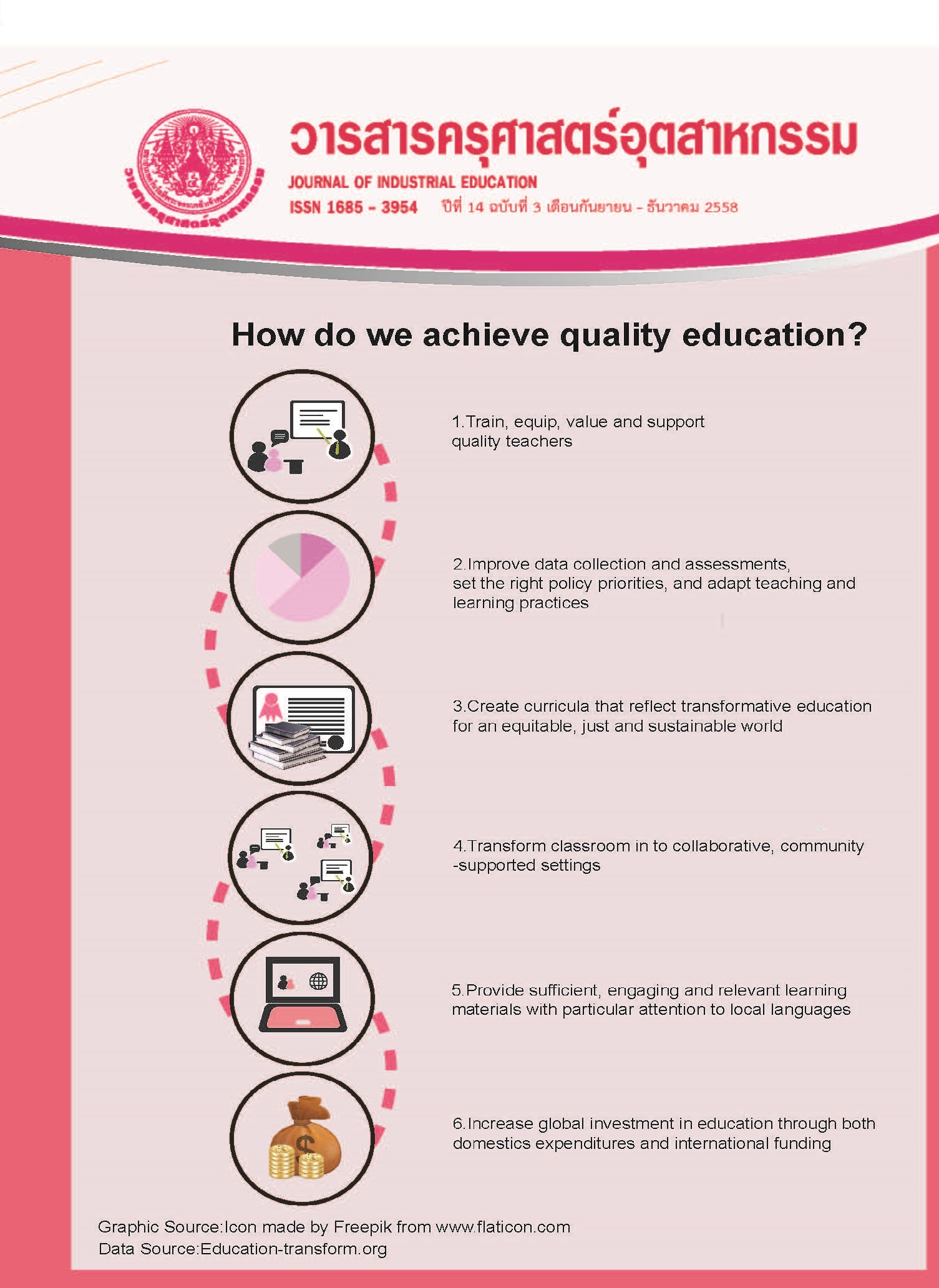The effect of Blended Learning on Achievement of Career and Technology 4 for Grade 11 students
Main Article Content
Abstract
Blended instruction in Career and Technology 4 is a combination between a conventional instruction focusing on classroom participation and a media technology assisted instruction by integrating advantages of both approaches in designing a blended instruction with higher efficiency. The objectives of the study were 1) to develop and examine efficiency of an e-learning instruction on Career and Technology 4 subject and 2) to compare learning achievement between Grade 11 students who learned with blended instruction and the conventional approach. The samples in this study were Grade 11 students in 3 classrooms (40 students each) from a total of 7 classrooms who enrolled Career and Technology 4 subject at Sriboonyanon School in the academic year 2014, selected by using cluster random sampling method. The 3 samples were used for courseware efficiency examination, blended instruction, and conventional instruction, respectively. The research instruments included a blended e-learning instruction on Career and Technology 4, an instruction evaluation form and a 20-item learning achievement test with the Item Objective Congruence Index (IOC) = 1.00, difficulty Index = 0.38-0.80, discrimination = 0.25-0.65 and reliability = 0.89. The data were analyzed by using t-test.
The results showed that efficiency E1/E2 of the instruction was at 92.92/94.38, and learning achievement in Career and Technology 4 of the students learning with the blended instruction was significantly higher than the students learning with the conventional instruction at 0.05.
Article Details
"The opinions and contents including the words in papers are responsibility by the authors."
"ข้อคิดเห็น เนื้อหา รวมทั้งการใช้ภาษาในบทความถือเป็นความรับผิดชอบของผู้เขียน"
References
[2] จินตวีร์ คล้ายสังข์. 2556. e-Learning Courseware: อีเลิร์นนิงคอร์สแวร์แนวคิดสู่การปฏิบัติสำหรับการเรียนการสอนอีเลิร์นนิงในทุกระดับ. กรุงเทพฯ: จุฬาลงกรณ์มหาวิทยาลัย.
[3] Tanamit, Kongkiat. 2551. Blended Learning. ค้นเมื่อวันที่ 20 มกราคม 2557, จากhttps://www.chontech.ac.th/~abhichat/e_book/FlippingBook/blended_learning/files/blended_learning.pdf
[4] ศิริรัตน์ เพ็ชร์แสงศรี. 2554.การเรียนแบบผสมผสานและการประยุกต์ใช้.วารสารครุศาสตร์อุตสาหกรรม, 11(1), น. 1-5.
[5] มนต์ชัย เทียนทอง. 2549.การออกแบบและพัฒนาคอร์สแวร์สําหรับบทเรียนคอมพิวเตอร์ช่วยสอน. กรุงเทพฯ: งานเอกสารและการพิมพ์กองบริการการศึกษา สถาบันเทคโนโลยีพระจอมเกล้าพระนครเหนือ.
[6] ผดุงชัย ภู่พัฒน์. 2556.เอกสารประกอบการบรรยายการวัดและประเมินผลการเรียนรู้. กรุงเทพฯ :สาขาวิชาครุศาสตร์อุตสาหกรรมคณะครุศาสตร์อุตสาหกรรม สถาบันเทคโนโลยีพระจอมเกล้าเจ้าคุณทหารลาดกระบัง.(เอกสารอัดสำเนา).
[7] พิชิตทธิ์ จรูญ. 2556.หลักการวัดแลประเมินผลการศึกษา. กรุงเทพฯ:เฮ้าส์ ออฟ เคอร์มิสท์.
[8] ดารุณี ถึงลาภ. 2552.การสร้างและหาประสิทธิภาพสื่อประกอบการสอนแบบผสมผสานวิชาการอ่านตีความ (EN202) หลักสูตรปริญญาตรี มหาวิทยาลัยรามคำแหง.วิทยานิพนธ์ปริญญาครุศาสตร์อุตสาหกรรมมหาบัณฑิต สาขาวิชาเทคโนโลยีคอมพิวเตอร์ ภาควิชาคอมพิวเตอร์ศึกษา บัณฑิตวิทยาลัย มหาวิทยาลัยเทคโนโลยีพระจอมเกล้าพระนครเหนือ
[9] นพดล จักรแก้ว. 2556. การพัฒนาบทเรียนผ่านระบบเครือข่ายอินเทอร์เน็ตเพื่อการทบทวน เรื่อง ภาษาซี วิชา การเขียนโปรแกรมเชิงโครงสร้าง. วารสารครุศาสตร์อุตสาหกรรม, 12(2), น. 32-37.
[10] เอกชัย ศิริเลิศพรรณนา. 2556. การพัฒนาบทเรียนผ่านเครือข่ายอินเทอร์เน็ตเพื่อทบทวน เรื่องการเคลื่อนที่แบบโมชั่นทวีน. วารสารครุศาสตร์อุตสาหกรรม, 12(3), น. 38-46.
[11] สายชล จินโจ. 2553. การพัฒนารูปแบบการสอนแบบผสมผสานรายวิชาการเขียนโปรแกรมภาษาคอมพิวเตอร์ 1 สาขาคอมพิวเตอร์ธุรกิจ.วิทยานิพนธ์ปริญญาปรัชญาดุษฎีบัณฑิต สาขาวิชาคอมพิวเตอร์ศึกษา ภาควิชาคอมพิวเตอร์ศึกษาบัณฑิตวิทยาลัย มหาวิทยาลัยเทคโนโลยีพระจอมเกล้าพระนครเหนือ.
[12] สุไลมาน ยะโก. 2554.ผลของการเรียนแบบผสมผสานที่พัฒนาตามแนวคิดการเรียนรู้แบบร่วมมือที่มีผลต่อผลสัมฤทธิ์ทางการเรียนวิชาคณิตศาสตร์ของรักเรียนชั้นมัธยมศึกษาปีที่ 5 ในจังหวัดยะลา. วิทยานิพนธ์ปริญญาศึกษาศาสตรมหาบัณฑิต สาขาวิชาเทคโนโลยีและสื่อสารการศึกษา บัณฑิตวิทยาลัยมหาวิทยาลัยสงขลานครินทร์.

